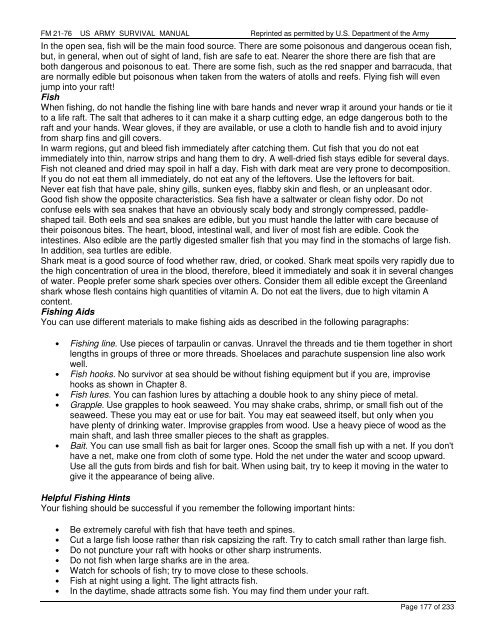FM 21-76 US ARMY SURVIVAL MANUAL
Create successful ePaper yourself
Turn your PDF publications into a flip-book with our unique Google optimized e-Paper software.
<strong>FM</strong> <strong>21</strong>-<strong>76</strong> <strong>US</strong> <strong>ARMY</strong> <strong>SURVIVAL</strong> <strong>MANUAL</strong> Reprinted as permitted by U.S. Department of the Army<br />
In the open sea, fish will be the main food source. There are some poisonous and dangerous ocean fish,<br />
but, in general, when out of sight of land, fish are safe to eat. Nearer the shore there are fish that are<br />
both dangerous and poisonous to eat. There are some fish, such as the red snapper and barracuda, that<br />
are normally edible but poisonous when taken from the waters of atolls and reefs. Flying fish will even<br />
jump into your raft!<br />
Fish<br />
When fishing, do not handle the fishing line with bare hands and never wrap it around your hands or tie it<br />
to a life raft. The salt that adheres to it can make it a sharp cutting edge, an edge dangerous both to the<br />
raft and your hands. Wear gloves, if they are available, or use a cloth to handle fish and to avoid injury<br />
from sharp fins and gill covers.<br />
In warm regions, gut and bleed fish immediately after catching them. Cut fish that you do not eat<br />
immediately into thin, narrow strips and hang them to dry. A well-dried fish stays edible for several days.<br />
Fish not cleaned and dried may spoil in half a day. Fish with dark meat are very prone to decomposition.<br />
If you do not eat them all immediately, do not eat any of the leftovers. Use the leftovers for bait.<br />
Never eat fish that have pale, shiny gills, sunken eyes, flabby skin and flesh, or an unpleasant odor.<br />
Good fish show the opposite characteristics. Sea fish have a saltwater or clean fishy odor. Do not<br />
confuse eels with sea snakes that have an obviously scaly body and strongly compressed, paddleshaped<br />
tail. Both eels and sea snakes are edible, but you must handle the latter with care because of<br />
their poisonous bites. The heart, blood, intestinal wall, and liver of most fish are edible. Cook the<br />
intestines. Also edible are the partly digested smaller fish that you may find in the stomachs of large fish.<br />
In addition, sea turtles are edible.<br />
Shark meat is a good source of food whether raw, dried, or cooked. Shark meat spoils very rapidly due to<br />
the high concentration of urea in the blood, therefore, bleed it immediately and soak it in several changes<br />
of water. People prefer some shark species over others. Consider them all edible except the Greenland<br />
shark whose flesh contains high quantities of vitamin A. Do not eat the livers, due to high vitamin A<br />
content.<br />
Fishing Aids<br />
You can use different materials to make fishing aids as described in the following paragraphs:<br />
• Fishing line. Use pieces of tarpaulin or canvas. Unravel the threads and tie them together in short<br />
lengths in groups of three or more threads. Shoelaces and parachute suspension line also work<br />
well.<br />
• Fish hooks. No survivor at sea should be without fishing equipment but if you are, improvise<br />
hooks as shown in Chapter 8.<br />
• Fish lures. You can fashion lures by attaching a double hook to any shiny piece of metal.<br />
• Grapple. Use grapples to hook seaweed. You may shake crabs, shrimp, or small fish out of the<br />
seaweed. These you may eat or use for bait. You may eat seaweed itself, but only when you<br />
have plenty of drinking water. Improvise grapples from wood. Use a heavy piece of wood as the<br />
main shaft, and lash three smaller pieces to the shaft as grapples.<br />
• Bait. You can use small fish as bait for larger ones. Scoop the small fish up with a net. If you don't<br />
have a net, make one from cloth of some type. Hold the net under the water and scoop upward.<br />
Use all the guts from birds and fish for bait. When using bait, try to keep it moving in the water to<br />
give it the appearance of being alive.<br />
Helpful Fishing Hints<br />
Your fishing should be successful if you remember the following important hints:<br />
• Be extremely careful with fish that have teeth and spines.<br />
• Cut a large fish loose rather than risk capsizing the raft. Try to catch small rather than large fish.<br />
• Do not puncture your raft with hooks or other sharp instruments.<br />
• Do not fish when large sharks are in the area.<br />
• Watch for schools of fish; try to move close to these schools.<br />
• Fish at night using a light. The light attracts fish.<br />
• In the daytime, shade attracts some fish. You may find them under your raft.<br />
Page 177 of 233





